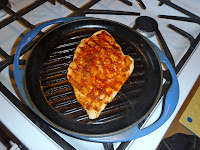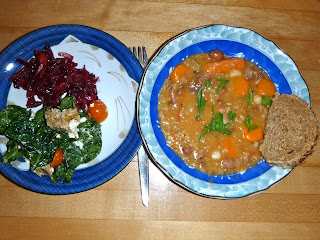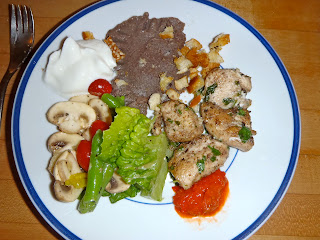Menu
Bograč (Slovenian Goulash Soup)
Crostini
Green Salad (dandelion greens with cabbage, tomatoes, and zucchini)
Goulash soup was the very first thing I tasted on my trip to Eastern Europe.
My husband and I, along with my in-laws, had just arrived in Vienna, after seventeen hours of flying. Our guide pointed us in the direction of an airport café, where we had an hour to pass while she waited for a few more members of the tour group to arrive.
We had departed from San Francisco at seven in the morning, changed planes in New York and Paris, and arrived in Vienna at what felt like midnight. It was just past ten in the morning, local time. I was excited, disoriented, exhausted. And hungry. But what to eat?
The waiter was a young guy with a shaved head and a forbidding stare. He took one look at us, slapped an English language menu down on the table, and stalked off.
It turned out we were in a genuine little bistro, a sort of all-hours workingman's haunt that opened onto the street. There were plenty of traditional food choices. Still, when I spotted the listing for goulash soup, I suspected it might be a tourist special. A sort of watered-down version of the real thing. But it did sound appealing, especially in my weakened state.
That goulash soup was delicious, with plenty of heat. Along with the apple strudel and coffee that followed, it was a perfect meal to revive a weary traveller.
Six years later, as I was planning my Tuesday night Slovenian dinner, I was anticipating the arrival of another traveller: our journalist son, coming home for a visit. He would be arriving at San Francisco's airport on Friday, late in the evening. So I wanted a dish that would do double duty, a meal for us and then, a few days later, a late night snack for him.
Goulash immediately came to mind. Perhaps I was even thinking of my own first meal in Vienna.
I had already made a couple of successful versions of goulash with sauerkraut, but I wanted to try something different. As a starting point, I found a recipe in Woman's Glory, one my vintage cookbooks. It was a simple beef/pork goulash with tomatoes, onions, and potatoes, along with paprika.
I continued to search. That's how I discovered that goulash soup is actually a distinctive dish called bograč. And there is nothing mild about it.
Bograč (“boh-gratch”) is named for the special Hungarian cooking pot in which it is traditionally prepared, a cast iron kettle that is suspended over an outdoor fire. The origins of this dish may be Hungarian, but the Slovenians have raised it to an art form. It is especially popular in Prekmurje, the northeast part of the country that borders Hungary, where there is an annual Bograč Festival, complete with cooking teams who compete. (Here is a nice report of the festival, by a British traveller.)
Recipes vary. It is common for two or three types of meat to be combined, including game. The distinctive elements seem to be large quantities of onions, potatoes (but no sauerkraut), and the addition of hot chili peppers along with paprika. So bograč is both hotter and more soupy than the typical goulash.
To come up with the recipe below, I drew on a few sources, starting with the simple Slovenian goulash recipe in Woman's Glory. My mid-1980s find, The Yugoslav Cookbook, also had a recipe for Bograč, or Goulash Soup.
Then I found a quirky but charming blog called Food for Hunters, by a young California couple. They had a long, funny entry about their attempts to make a dish they called Slovenian Stew: Prekmurksi Bograč. I wasn't about to shoot my own game, but I liked their seasoning choices. And it was nice to have someone else do the metric conversions!
Bograč (Slovenian Goulash Soup)
¾ lb. beef stew meat, cubed
¾ lb. pork stew meat, cubed
1 large onion, sliced
2 large cloves garlic, chopped
1 green pepper, sliced
1 t. caraway seed
1 T. paprika (half hot, half smoked)
½ t. marjoram
salt and pepper to taste
½ c. crushed tomatoes
1 lb. potatoes, cut in chunks
water to cover
olive oil
(other options: rosemary; red or white wine)
Brown onion in olive oil, using a large pot or Dutch oven. Add garlic and continue to brown. Remove to another bowl. Add meats to oil left in pot and brown. Add green pepper and spices and continue to brown. Return onion and garlic to the pot. Add crushed tomatoes and enough water to cover. Simmer until meat is tender and almost done. Add potatoes and simmer another hour. Taste and adjust seasonings. Serve garnished with parsley.
The verdict: This was delicious, even though I forgot to add a couple of seasoning options, rosemary and wine, that might have enhanced the dish. As I had hoped, the bograč improved with re-heating. The following night, my husband and I thought the meat was more tender and the flavor was even better.
And by Friday, it was a welcome midnight dinner for our son, who is something of a foodie. In college, he spent a semester studying in Hungary and travelled all over the Balkans. He currently lives and works in Kosovo. Slovenian food, in his view, is a little bland, compared to his usual fare. So it was most gratifying to see him surprised by the assertive flavor of my bograč!
Update: A month later, I made bograč again. This time it was all beef, and I remembered to add the rosemary and a little wine! There were a few other additions, too. To take a look at Bograc II, go here.
Update: A month later, I made bograč again. This time it was all beef, and I remembered to add the rosemary and a little wine! There were a few other additions, too. To take a look at Bograc II, go here.














































